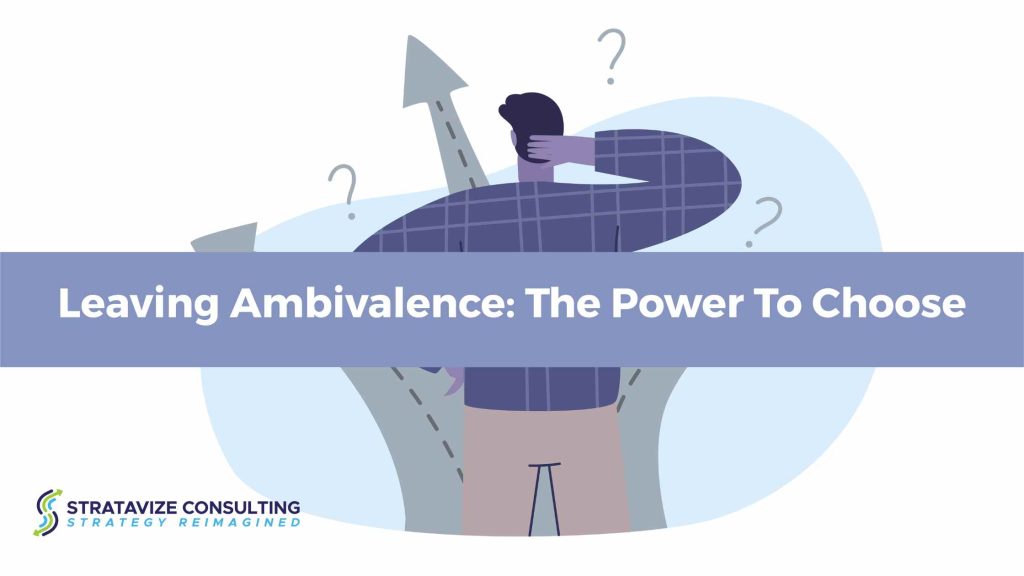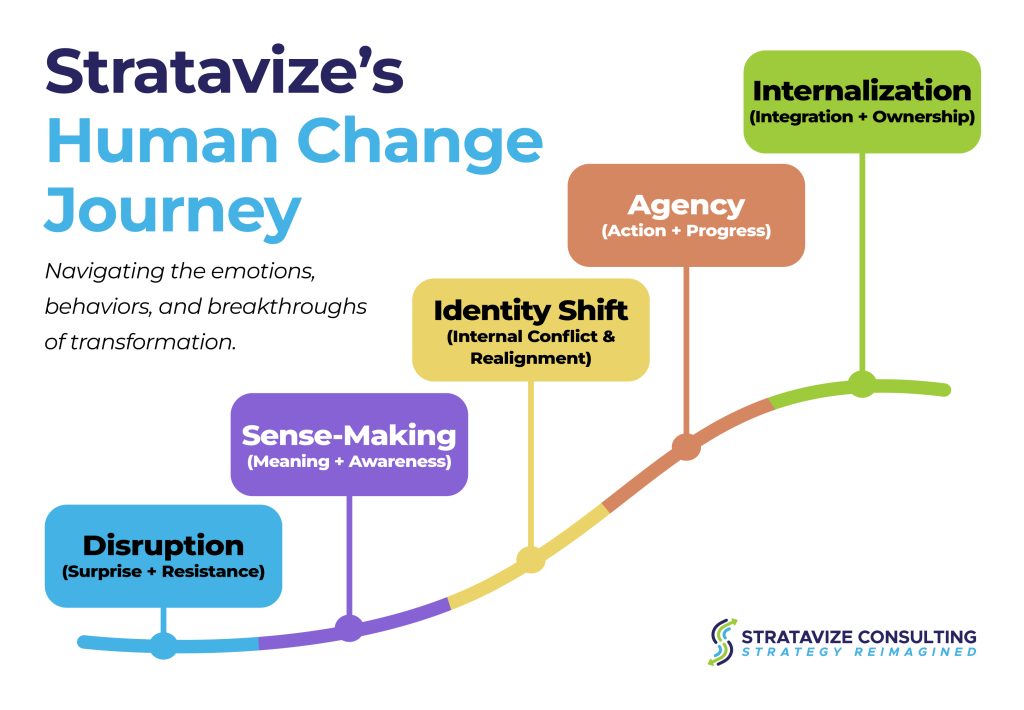
Have you ever wrestled with opposing sides of a decision? This is ambivalence.
Maybe it’s a job, should I stay or should I go?
Maybe it’s an employee, do I keep them or let them go?
Perhaps it’s the mixed feelings you have for a friend or family member that keeps you up at night.
Or should you start a new business or not?
I’ve lived in a state of near-debilitating ambivalence. The internal conflict became overwhelming. Yet, deep down, I knew I must make a decision. When I began seeking wisdom from others, I found that I was not alone. It’s just another thing we share as part of the human experience.
What Living In A State of Ambivalence Does To Us
Ambivalence causes emotional and cognitive discomfort, which can lead to slow decision-making, indecision, or, my personal favorite, complete avoidance. Yet, when our state of ambivalence becomes so intense, it can force us to take emotionally charged action to escape the internal tension.
What’s my biggest fear? I will make the wrong decision.
Here’s what I know to be true.
I am not alone in the desire to put off a decision to ensure the decision is made PERFECTLY with ZERO REGRET. Aka kicking the can.
Here’s the reality for you and me: as sure as we are that a decision must be made, we can equally be sure it will likely not be perfect or without consequence. Whether you choose to keep the employee or terminate them, both will have consequences and tradeoffs. Whether you stay in the job or go, there will be consequences and tradeoffs.
However, there is a way to exit ambivalence to make a choice and accept the decision, along with accepting the path not chosen.
Building Our Internal Capacity To End Ambivalence
So, how do we build our capacity for ending our state of ambivalence?
We can begin by acknowledging the conflict and accepting it.
Second, here’s the most critical next step…. we must come into alignment with our values and forgive ourselves for the path not chosen.
Third, which is the last step, is understanding the liminal state we are in and the change ahead of us.
Steps To Choosing and Accepting Our Choices
Step 1: Acknowledge the Conflict and Accept It
The first step in leaving our state of ambivalence is acknowledging the internal conflict and becoming introspective.
How to do it:
Begin by clearly naming both sides of the ambivalence by writing them down. For example;
“I want to stay because of financial security… but I want to leave because I’m deeply unfulfilled.”
In your writing, use nonjudgmental language and avoid labeling either side as “bad” or “irrational.” Both perspectives hold valid emotional weight. Also, this is NOT a pros/cons list.
Feel the tension—don’t fix it immediately. Sit with the discomfort. Acknowledge: “This is hard. And it’s okay that it feels hard.” Acceptance doesn’t mean agreement—it simply means giving yourself permission to feel what you’re feeling.
Ask introspective questions:
- What am I afraid will happen if I choose one over the other?
- What would I tell a friend in this same situation?

Why Accepting Matters In This Process
Acceptance matters in the leaving ambivalence process because it lessens the emotional charge. When you acknowledge internal conflict without rushing to solve it, your brain becomes better equipped to access clarity and creativity.
Step 2: Come Into Alignment with Your Values
The next step in the leaving ambivalence process is to come into alignment with your values and your internal compass. Too often, we make decisions without considering our internal compass and the values we hold as part of defining who we are and what we will and will not do.
How to do it:
To revisit your personal values, name your top 3–5 core values. Add it just below where you’ve written out the sides of your decision. For example, one core value I have is FREEDOM. I make decisions based on whether the choice will increase my freedom to control my day or decrease it.
After you’ve brainstormed a list of your values, put them to the test by thinking about which values are being threatened or honored by each choice.
“When I look back on this season of my life, what will I be most proud of?”
Evaluate the options through a values lens by creating a simple chart where each column is an option (stay vs. go, fire vs. coach, etc.) and each row is a value (e.g., honesty, stability, creativity, connection). Score how well each option honors each value.
Watch for misalignment between the action and the value as an energy drain. If you’re living or working out of sync with your values, it will show up as stress, burnout, and decision fatigue.
Forgive yourself for the path not chosen.
Every yes has a no. Choosing in alignment with your values allows you to release the alternate path without regret, because you decided from clarity, not fear.
Step 3: Understand the Liminal State and Navigate Change
After the decision is made, you enter a liminal space—the in-between. It’s no longer what it was, but not yet what it will be.

This is where the Stratavize Human Experience of Change Journey becomes essential. It gives you a roadmap to move from decision to sustainable action:
Stratavize Human Experience of Change Journey
This model outlines five phases of change—not just for organizations, but for people, too:
- Disruption and Acknowledgment
- What to do: Validate your feelings of grief, fear, or excitement about what’s changing.
- Action: Give yourself (or your team) language to say, “This is happening, and it’s okay to feel uncertain.”
- Sense Making and Understanding
- What to do: Seek to understand what is changing and why.
- Action: Ask, “What do I need to learn or unlearn in this new chapter?”
- Identity Shift and Exploration
- What to do: Begin trying small steps aligned with the new path.
- Action: Test ideas, rehearse scripts, talk to mentors, adjust routines.
- Agency and Integration
- What to do: Start embedding the new choice into daily life.
- Action: Build habits, create rituals, reward progress.
- Internalization and Reinforcement
- What to do: Solidify the change and celebrate growth.
- Action: Reflect monthly on what has shifted. What are you proud of? What needs re-alignment?
Bonus Tip:
Use a “Change Companion” – a trusted friend, mentor, coach, or team member who walks this journey with you.
Final Thought
Ambivalence is not weakness. It’s wisdom knocking at the door—telling you something matters.
You don’t have to make the perfect decision.
You just have to make a true one.
Choose with courage.
Choose with care.
But above all, choose.
About the Author: Lauralee Hites

I spent years in Corporate America at Accenture, Microsoft, and Wells Fargo before deciding that helping organizations thrive was far more fulfilling than simply being another corporate cog.
Now, as the founder of Stratavize Consulting, I am on a mission to help leaders build better workplaces—where people actually want to show up.
I was lucky enough to receive an award for writing and was recently named Alumni of the Year by Ivy Tech.
I have a business degree, a master’s in executive leadership and innovation (yep, that’s a thing), and a knack for making workshops and retreats feel more like exciting trips than boring boardroom meetings.
Outside of work, I love paddling whitewater, traveling to far-flung places, or trying to convince my Corgi, Nala, to like hiking as much as I do.
Follow me on LinkedIN or sign up to receive my newsletter each month.
